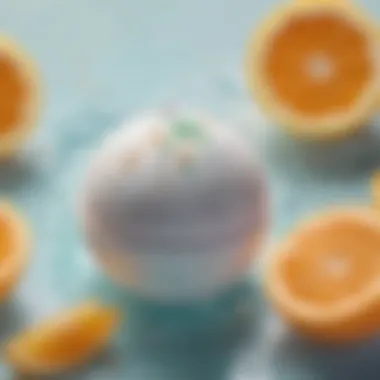Unlocking the Luxurious Benefits of Citric Acid in Bath Bombs


Science Fun Facts
Did you know that citric acid plays a crucial role in creating the fizzing action of bath bombs? This powerhouse ingredient contributes to the effervescence that makes your bath time experience so enjoyable.
Discover the Wonders of Science
By incorporating citric acid into bath bombs, you are essentially creating a mini science experiment in your bathtub. Witness the chemical reaction between citric acid and bicarbonate of soda as they combine to produce carbon dioxide gas, resulting in the delightful bubbling effect.
Science Experiment Showcase
For a fun and engaging experiment at home, try making your own bath bombs using citric acid. Gather materials such as citric acid powder, baking soda, essential oils for fragrance, and molds. Follow step-by-step instructions carefully, considering safety tips like wearing gloves to protect your skin from direct contact with citric acid. Enjoy the process of crafting your luxurious bath bombs while also learning about the science behind them.
Introduction
In the realm of bath bomb creation, the incorporation of citric acid stands as a pivotal element that enhances not only the visual appeal but also the overall bathing experience. Citric acid, a compound found in various fruits like lemons and oranges, possesses remarkable properties that lend themselves beautifully to the world of bath bombs. Its significance lies in its ability to induce effervescence, elevate fragrances, and nourish the skin, making it an indispensable ingredient for those seeking a luxurious bath indulgence. By understanding the science behind citric acid and its interaction with other components in bath bombs, one can unlock a trove of benefits that contribute to a holistic and rejuvenating bathing experience.
The exploration of citric acid in the realm of bath bombs ushers in a new era of luxury and self-care where individuals can craft personalized bathing rituals tailored to their preferences. As we delve into the intricacies of this compound's properties, we unveil a world of possibilities where effervescence, fragrance enhancement, and skin benefits converge to deliver a sensory experience like no other. Through the synergy of citric acid with other ingredients, bath bomb enthusiasts can embark on a journey of sensory delight and skin-nourishing treatments, turning ordinary baths into extraordinary escapes.


One of the key considerations in harnessing the benefits of citric acid in bath bombs is the precise balance required to achieve the desired effervescent effect without compromising the structural integrity of the product. Understanding the chemical behavior of citric acid and its role in the effervescence process empowers bath bomb artisans to master the art of bubble formation and release, ensuring a mesmerizing display in the bathtub. Moreover, the aroma-enhancing properties of citric acid open doors to a realm of olfactory pleasure, allowing bathers to immerse themselves in a symphony of scents that uplift the mood and soothe the senses.
By embarking on this journey of discovery into the realm of citric acid's benefits in bath bombs, readers are poised to unlock a treasure trove of knowledge that transcends traditional bathing experiences. From subtle fizzing sensations to indulgent fragrances and skin-pampering effects, the integration of citric acid revolutionizes the way we perceive and indulge in self-care rituals, elevating mundane baths to spa-like retreats within the confines of our homes.
Understanding Citric Acid
In delving into the topic of understanding citric acid within the realm of crafting bath bombs, it becomes imperative to comprehend the pivotal role this compound plays in enhancing the overall efficacy and experience of these indulgent products. By dissecting the chemical composition and natural sources of citric acid, we can grasp its multifaceted benefits and applications within the realm of bath bomb formulation.
Chemical Composition
Citric Acid Structure
Citric acid structure forms the fundamental basis of its functionality within bath bombs. Its molecular arrangement, characterized by three carboxylic acid functional groups, acts as a potent acidulant capable of reacting synergistically with other key ingredients such as baking soda. This intricate structure renders citric acid a versatile and vital component in bath bomb recipes, contributing significantly to their effervescence and sensory appeal. Despite its complex arrangement, citric acid structure's compatibility and solubility make it an ideal choice for formulators seeking consistent and reliable results.
Acidity Levels
Within the spectrum of acidity levels, citric acid exudes a distinct profile that underpins its efficacy in bath bomb formulations. Its moderate acidity provides the perfect balance necessary for triggering the desired fizzing action when combined with alkaline agents like baking soda. This unique characteristic enables citric acid to enhance the sensory experience of bath bombs while maintaining a gentle and skin-friendly acidity level. By leveraging specific acidity levels, formulators can fine-tune the performance and qualities of their bath bomb creations, ensuring a harmonious blend of effervescence and safety.
Natural Sources


Fruits and Vegetables
The natural derivation of citric acid from fruits and vegetables introduces a holistic dimension to its utilization in bath bombs. Extracted from citrus fruits like lemons and oranges, as well as various vegetables, this naturally sourced citric acid carries with it a purity and freshness that aligns perfectly with the organic trend in skincare products. Incorporating citric acid sourced from fruits and vegetables not only infuses bath bombs with a revitalizing essence but also ensures a wholesome and nourishing bathing experience for users.
Manufacturing Process
When exploring the manufacturing process of citric acid, we uncover a meticulous method that guarantees the quality and efficacy of this compound in bath bombs. Produced through fermentation or microbial processes, citric acid manufacturing follows strict protocols to maintain high purity levels essential for cosmetic applications. This controlled production process not only standardizes the quality of citric acid but also validates its safety for use in skincare products, offering formulators a trusted ingredient for crafting premium bath bombs.
Benefits of Citric Acid in Bath Bombs
Citric acid plays a pivotal role in the effectiveness of bath bombs. Its ability to generate effervescence, enhance fragrances, and promote skin benefits makes it an indispensable ingredient in bath bomb formulations. The significance of citric acid lies in its chemical properties, particularly its reaction with baking soda, which initiates the fizzing action that bath bombs are renowned for. Understanding the diverse benefits that citric acid offers allows bath bomb enthusiasts to create products that deliver a luxurious and therapeutic bathing experience. ### rvescence ### Eff cence is a key element in bath bombs, imparting the satisfying fizzing sensation upon contact with water. The reaction between citric acid and baking soda is responsible for this effervescent display. Citric acid's ability to react exothermically with baking soda triggers carbon dioxide release, leading to bubbles and fizzing. This fizzing action not only creates an entertaining spectacle but also enhances the tactile and sensory experience of using bath bombs, transforming a mundane bath into a spa-like indulgence. ### Reactio h Baking Soda ### The interac between citric acid and baking soda is a fundamental aspect of bath bomb chemistry. When citric acid, a weak organic acid, combines with baking soda, a basic compound, a chemical reaction occurs, resulting in the production of carbon dioxide gas. This gas release drives the effervescence seen in bath bombs, producing bubbling and foaming that makes the bath bomb dissolve and disperse essential oils and other added ingredients evenly in the bathwater. ### Fizzing Action he fizzing action th bombs, initiated by the reaction between citric acid and baking soda, offers a multisensory experience. As the bath bomb dissolves, the fizzing creates a dynamic effervescent environment that invigorates the mind and body. The tactile sensation of bubbles bursting against the skin adds a textural dimension to the bath, enhancing relaxation and rejuvenation. This fizzy spectacle, accompanied by aromatic scents and skin-nourishing ingredients, elevates the bathing ritual to a sumptuous self-care indulgence. ### Fragrance Enhancement # tric acid contributes sig antly to enhancing the fragrance profile of bath bombs. By stabilizing and preserving scents, citric acid ensures that the aroma remains potent and long-lasting during bath time. The aromatherapy benefits of bathing with scented bath bombs enrich the sensory experience, offering a therapeutic escape from daily stressors. Citric acid's role in maintaining scent stability guarantees a consistent and enjoyable fragrance release, allowing users to immerse themselves in a fragrant sanctuary within their own bathroom. ### Aromatherapy Benefits ### The i oration of citric acid in bombs enhances the aromatherapy benefits of essential oils used in the formulation. Citric acid helps disperse essential oils evenly throughout the bathwater, ensuring a uniform distribution of aromatic molecules. This even dispersion maximizes the olfactory impact of the essential oils, enveloping the bather in a fragrant cloud that calms the mind, uplifts the mood, or promotes relaxation, depending on the chosen oils' properties. The combination of aromatherapy benefits with the effervescence of citric acid-driven fizzing elevates the sensory experience of bath time, creating a luxurious spa-like ambiance at home.
Incorporating Citric Acid Into Bath Bomb Recipes
In the realm of bath bomb creation, the inclusion of citric acid holds paramount significance. This vital ingredient plays a pivotal role in determining the effervescence, fragrance intensity, and skin benefits of the final product. By understanding how citric acid interacts with other components such as baking soda, bath bomb artisans can master the art of creating bath bombs that not only fizz spectacularly but also pamper the skin and elevate the overall bathing experience. The process of incorporating citric acid into bath bomb recipes requires precision and knowledge to strike the perfect balance of acidity and reaction rates to achieve optimal results. Crafting these delightful bathing companions involves a careful blend of science and artistry, where citric acid serves as a key player in creating a luxurious and rejuvenating experience.
Recipe Formulation Tips


Proper Ratios
A crucial element in the formulation of bath bomb recipes is ensuring the correct ratios of ingredients, particularly citric acid. Proper ratios play a vital role in achieving the desired fizzing action, fragrance diffusion, and skin-nourishing benefits. Too much or too little citric acid can significantly impact the overall quality of the bath bomb, affecting factors such as texture, scent longevity, and effervescence. Crafting bath bombs with the proper ratios of citric acid not only enhances their performance but also ensures a harmonious sensory experience for the user. This attention to detail in ratio management underscores the craftsmanship involved in creating top-tier bath products.
Mixing Techniques
In the realm of bath bomb production, mastering the art of mixing techniques is key to achieving consistent quality and performance. The way ingredients are blended together, particularly citric acid with other components, can influence factors such as fizzing stability, fragrance distribution, and overall texture. Understanding the optimal mixing techniques for incorporating citric acid ensures thorough dispersion throughout the bath bomb mixture, leading to a balanced and effective product. Whether it's hand mixing for precision or mechanical blending for efficiency, the choice of mixing technique profoundly impacts the final outcome of the bath bomb, highlighting the craftsmanship and attention to detail required in the creation process.
Troubleshooting Common Issues
Over-Fizzing
When dealing with bath bomb formulations, over-fizzing can be a common challenge caused by imbalances in ingredient proportions, particularly citric acid and baking soda. This issue not only affects the visual appeal of the bath bomb but can also impact its performance and longevity. Understanding the factors that contribute to over-fizzing, such as excess citric acid or inadequate blending, allows bath bomb makers to troubleshoot effectively and adjust their recipes for a more controlled fizzing experience. By addressing the root cause of over-fizzing, artisans can refine their craft and deliver bath bombs that fizz harmoniously, providing a delightful bathing experience.
Lack of Scent
A prevalent issue in bath bomb production is the lack of scent intensity, which can detract from the overall sensory experience. Insufficient fragrance dispersion, often related to improper citric acid integration, can lead to underwhelming scent profiles in the final product. Resolving the issue of scent deficiency requires a comprehensive understanding of how citric acid interacts with fragrances and other ingredients. By implementing precise scent incorporation techniques and optimizing citric acid distribution, bath bomb creators can overcome the challenge of scent fading and ensure a long-lasting, aromatic bathing experience for users. Addressing the lack of scent in bath bombs underscores the artistry and dedication required to craft exceptional aromatic products.
Conclusion
In elucidating the merits and advantages of incorporating citric acordin bath bombs, the conclusion acts as a pivotal summation of the discourse. As readers journey through the preceding sections unveiling the wonders of citric acid, this conclusive segment serves as a compass, guiding them towards an enriched understanding regarding the significance of this pervasive ingredient in bath bomb formulation. By encapsulating the discussions on effervescence, fragrance elevation, and skin nourishment, the conclusion crystallizes the essence of citric acid's multi-faceted contributions to the realm of bath products.
Undoubtedly, the relevance of the conclusion lies in acquainting readers with the pivotal roles that citric acayspy within bath bombs. It sheds light on how citric acid serves as the catalyst for effervescence, instigating a delightful bubbling reaction when combined with baking soda. Moreover, the significance of fragrance enhancement facilitated by citric acid imparts a sensorial journey to bath time, enveloping users in a symphony of delightful scents that uplift and invigorate. Skin benefits, another cornerstone highlighted in this conclusive segment, emphasize how citric acid aids in exfoliation, sloughing off dead skin cells to reveal a radiant complexion, while simultaneously boasting moisturizing effects that nurture the skin into a supple state of hydration.
For crafting opulent bath experiences, the conclusion encapsulates the crux of citric acid's efficacy. Readers are urged to recognize the nuanced attributes of this seemingly humble ingredient and its transformative potential within bath bomb formulations. From the tantalizing fizz upon immersion to the lingering aroma that soothes the senses, citric acid emerges as a indispensable component in the alchemy of bath time indulgence. Therefore, to disregard the revelations expounded in this concluding segment would be to overlook the intricacies and advantages that citric acid bestows upon the realm of self-care and pampering.







